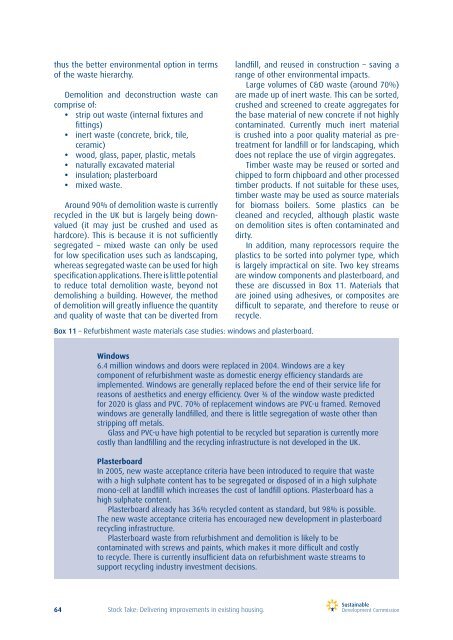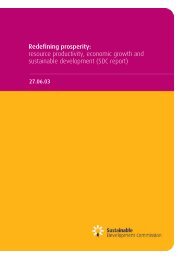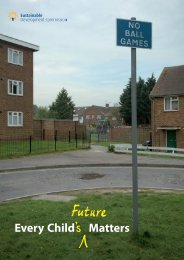Stock Take - Sustainable Development Commission
Stock Take - Sustainable Development Commission
Stock Take - Sustainable Development Commission
- No tags were found...
Create successful ePaper yourself
Turn your PDF publications into a flip-book with our unique Google optimized e-Paper software.
thus the better environmental option in termsof the waste hierarchy.Demolition and deconstruction waste cancomprise of:• strip out waste (internal fixtures andfittings)• inert waste (concrete, brick, tile,ceramic)• wood, glass, paper, plastic, metals• naturally excavated material• insulation; plasterboard• mixed waste.Around 90% of demolition waste is currentlyrecycled in the UK but is largely being downvalued(it may just be crushed and used ashardcore). This is because it is not sufficientlysegregated – mixed waste can only be usedfor low specification uses such as landscaping,whereas segregated waste can be used for highspecification applications. There is little potentialto reduce total demolition waste, beyond notdemolishing a building. However, the methodof demolition will greatly influence the quantityand quality of waste that can be diverted fromlandfill, and reused in construction – saving arange of other environmental impacts.Large volumes of C&D waste (around 70%)are made up of inert waste. This can be sorted,crushed and screened to create aggregates forthe base material of new concrete if not highlycontaminated. Currently much inert materialis crushed into a poor quality material as pretreatmentfor landfill or for landscaping, whichdoes not replace the use of virgin aggregates.Timber waste may be reused or sorted andchipped to form chipboard and other processedtimber products. If not suitable for these uses,timber waste may be used as source materialsfor biomass boilers. Some plastics can becleaned and recycled, although plastic wasteon demolition sites is often contaminated anddirty.In addition, many reprocessors require theplastics to be sorted into polymer type, whichis largely impractical on site. Two key streamsare window components and plasterboard, andthese are discussed in Box 11. Materials thatare joined using adhesives, or composites aredifficult to separate, and therefore to reuse orrecycle.Box 11 – Refurbishment waste materials case studies: windows and plasterboard.Windows6.4 million windows and doors were replaced in 2004. Windows are a keycomponent of refurbishment waste as domestic energy efficiency standards areimplemented. Windows are generally replaced before the end of their service life forreasons of aesthetics and energy efficiency. Over ¾ of the window waste predictedfor 2020 is glass and PVC. 70% of replacement windows are PVC-u framed. Removedwindows are generally landfilled, and there is little segregation of waste other thanstripping off metals.Glass and PVC-u have high potential to be recycled but separation is currently morecostly than landfilling and the recycling infrastructure is not developed in the UK.PlasterboardIn 2005, new waste acceptance criteria have been introduced to require that wastewith a high sulphate content has to be segregated or disposed of in a high sulphatemono-cell at landfill which increases the cost of landfill options. Plasterboard has ahigh sulphate content.Plasterboard already has 36% recycled content as standard, but 98% is possible.The new waste acceptance criteria has encouraged new development in plasterboardrecycling infrastructure.Plasterboard waste from refurbishment and demolition is likely to becontaminated with screws and paints, which makes it more difficult and costlyto recycle. There is currently insufficient data on refurbishment waste streams tosupport recycling industry investment decisions.64 <strong>Stock</strong> <strong>Take</strong>: Delivering improvements in existing housing.








